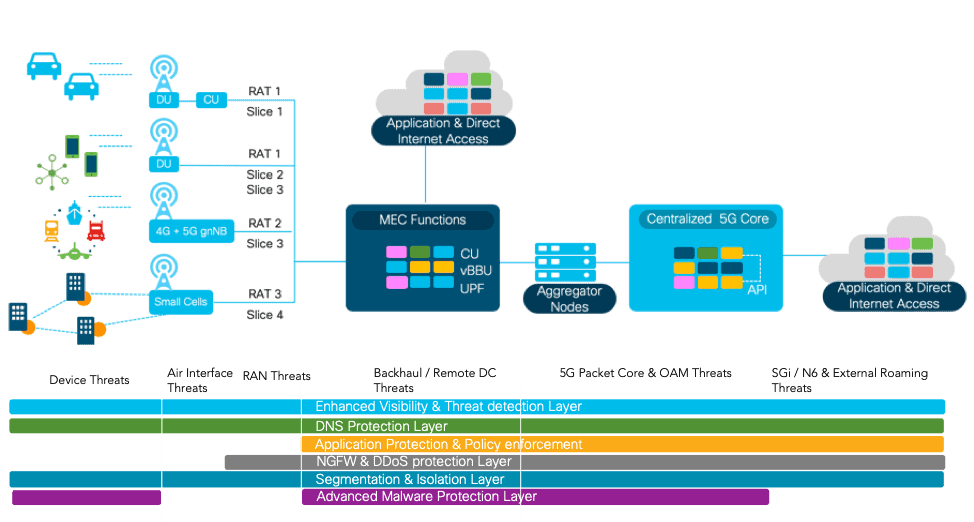
Why 5G is Changing our Approach to Security
13th July 2020
While earlier generations of cellular technology (such as 4G LTE) focused on ensuring connectivity, 5G takes connectivity to the next level by delivering connected experiences from the cloud to clients. 5G networks are visualised and software-driven, and they exploit cloud technologies. New use cases will unlock countless applications, enable more robust automation, and increase workforce mobility. Incorporating 5G technology into these environments requires deeper integration between enterprise networks and 5G network components of the service provider. This exposes enterprise owners (including operators of critical information infrastructure) and 5G service providers to risks that were not present in 4G. An attack that successfully disrupts the network or steals confidential data will have a much more profound impact than in previous generations.
5G technology will introduce advances throughout network architecture such as decomposition of RAN, utilising API, container-based 5G cloud-native functions, network slicing to name a few. These technological advancements while allowing new capabilities, also expand the threat surface, opening the door to adversaries trying to infiltrate the network. Apart from the expanded threat surface, 5G also presents the security team with an issue of a steep learning curve to identify and mitigate threats faster without impacting the latency or user experience.
What are Some of the Threats?
Virtualisation and cloud-native architecture deployment for 5G is one of the key concerns for service providers. Although virtualisation has been around for a while, a container-based deployment model consisting of 5G Cloud Native Functions (CNFs) is a fresh approach for service providers. Apart from the known vulnerabilities in the open-source components used to develop the 5G CNFs, most CNF threats are actually unknown, which is riskier. The deployment model of CNFs in the public and private cloud brings in another known, yet the widespread problem of inconsistent and improper access control permissions putting sensitive information at risk.
5G brings in network decomposition, disaggregation into software and hardware, and infrastructure convergence which underpins the emergence of edge computing network infrastructure or MEC (Multi-Access Edge Compute). 5G Edge computing use cases are driven by the need to optimise infrastructure through offloading, better radio, and more bandwidth to fixed and mobile subscribers. The need for low latency use cases such as Ultra-Reliable Low Latency Communication (URLLC) which is one of several different types of use cases supported by 5G NR, requires user plane distribution. Certain 5G specific applications and the user plane need to be deployed in the enterprise network for enterprise-level 5G services. The key threats in MEC deployments are fake/rogue MEC deployments, API-based attacks, insufficient segmentation, and improper access controls on MEC deployed in enterprise premises.
5G technology will also usher in new connected experiences for users with the help of massive IoT devices and partnerships with third-party companies to allow services and experiences to be delivered seamlessly. For example, in the auto industry, 5G combined with Machine Learning-driven algorithms will provide information on traffic, accidents and process peer to peer traffic between pedestrian traffic lights and vehicles in use cases such as Vehicle to Everything (V2X). Distributed Denial of Service (DDoS) in these use cases are a very critical part of the 5G threat surface.
What are Some of the Solutions to Mitigate Threats?
Critical infrastructure protection: Ensure your critical software, technologies, and network components such as Home Subscriber Server (HSS), Home Location Register (HLR), and Unified Data Repository (UDR) are secured with the right controls.
Cisco Secure Development Lifecycle: Being cloud-native and completely software-driven, 5G uses open source technologies. Although this is critical for scalability and allowing cloud deployment integrations, vulnerabilities from multiple open-source applications could be exploited by attackers. To reduce the attack surface, service providers need to verify the 5G vendor-specific secure development process to ensure hardened software and hardware. Cisco offer security built into their architectural components. Our trustworthy systems’ technology includes trust anchor, secure boot, entropy, immutable identity, image signing, common cryptography, secure storage, and run-time integrity.
Vendor Assessment (security): It’s critical to validate the vendor supply chain security, secure your organisation’s development practices from end to end, and employ trustworthy products. You must also be vigilant when it comes to continuously monitor hardware, software, and operational integrity to detect and mitigate infrastructure and service tampering. Sophisticated actors are looking to silently gain access and compromise specific behaviour in the network. These attackers seek to take control of network assets to affect traffic flows or to enable surveillance by rerouting or mirroring traffic to remote receivers. Once they have control, they might launch “man-in-the-middle” attacks to compromise critical services like Domain Name System (DNS) and Transport Layer Security (TLS) certificate issuance.
Secure MEC & Backhaul: 5G edge deployments will supply virtualisation, on-demand resource, an infrastructure that connects servers to mobile devices, to the internet, to the other edge resources and operational control system for management & orchestration. These deployments should have the right security mechanisms in the backhaul to prevent rogue deployments and right security controls to prevent malicious code deployments and unauthorised access. As these MEC deployments will include the dynamic virtualisation environments, securing these workloads will be critical. Cisco workload protection, will help service providers to secure the workloads. Cisco’s Converged 5G xHaul Transport will provide the service providers with the right level of features for secure 5G transport.
Cisco Ultra Cloud Core allows the user plane to support a full complement of inline services. These include Application Detection and Control (ADC), Network Address Translation (NAT), Enhanced Charging Service (ECS), and firewalls. Securing the MEC would require multiple layers of security controls based on the use case and the deployment mode. Some of the key security controls are:
- Cisco Security Gateway provides security gateway features along with inspections on GTP, SCTP, Diameter, and M3UA.
- Secure MEC applications: Securing virtualisation deployments on the MEC and centralised 5GC requires a smarter security control rather than just having firewalls, be it hardware or virtualized. Cisco Tetration provides multi-layered cloud workload protection using advanced security analytics and speedy detection.
- Secure MEC access: Securing user access to MEC can be catered by utilising the Zero Trust methodology, which is explained in greater detail below.
Utilising zero trust security controls during 5G deployment is critical for service providers. This is particularly important in the deployment phase where there will be multiple employees, vendors, contractors, and sub-contractors deploying and configuring various components and devices within the network. The old method of just providing a VPN as a security control is insufficient, as the device used by the configuration engineer might have an existing malicious code that might be deployed within the 5G infrastructure. This whitepaper gives you more insights on how zero trust security could be applied to 5G deployments.
End to End Visibility: 5G brings in distributed deployments, dynamic workloads, and encrypted interfaces like never before. This requires end-to-end visibility to ensure proper security posture. Advanced threat detection and encryption methods can identify malware in encrypted traffic without requiring decryption. And because latency is very important in 5G, we can’t use traditional methods of distributed certificates, decrypting traffic, analysing the data for threats, and then encapsulating it again, as this adds too much latency into the network. Cisco Stealthwatch is the only solution that detects threats across the private network, public cloud, and even in encrypted traffic, without the need for decryption.
Conclusion
5G is an evolving architecture that will require enhanced security mechanisms to cater to the widened threat surface. Cybersecurity is foundational to realising dependable and resilient 5G services. Cisco’s 5G solution has security included as a foundation. Government regulators and network operators must work hand-in-hand to ensure cybersecurity best practices and capabilities are designed into 5G infrastructure and operations right from the start.


